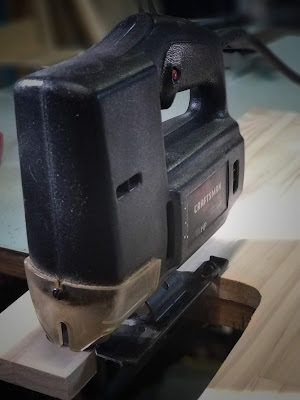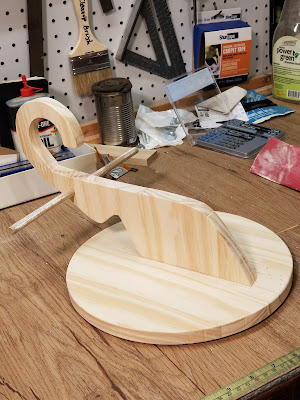Tool Handle Bird Feeder
Made at 173
This is yet another scrap wood project made entirely from stuff left over from other projects. In another bid at maintaining my sanity while I yearn for brighter days post-pandemic, and with the motivation of having rescued the old bird feeder, I figured here's a good excuse to get a few minutes of workshop time! A Tool Handle Bird Feeder!
From a Plans book
I'd love to say that this was a design of my own, but quite frankly - I'm just not that creative. But I am savvy enough to be able to follow directions! This was an interesting and simple bird feeder from the Build Your Own Birdhouses book by John Perkins.
What are we talking about here? It's quite simple really, it's a birdfeeder with a hook that fits over the handle of an old tool like a shovel.
All I needed was a tool on which to hang the feeder. As it turns out, the Mosher's left behind the perfect shovel for just such a thing, and it's been leaning against the shed since it was built back in 2000 or so!
Some woodworking and DIY books used here at 173
Non-sponsored links - these are books I actually use
∙ Build it Better Yourself: Country Furniture by The Family Handyman
∙ Build Your Own Birdhouses by John Perkins
∙ Home Improvement 1-2-3 by The Home Depot
∙ Reader's Digest Complete Do it Yourself Manual
Cutting a circle
I've never been good at drawing circles. Even as a kid when I'd try to trace around something to draw a circle, by the time I got to 360°- the ends wouldn't meet up. Even as recently as 2019 when I tried to cut half circles for the little hallway accent table...
Yeah, you remember the clothes basket! This project started out much the same way, but this time I used a nail and string to map out my circle.
But once again, at 360° - no connection! In a bit of a Grinch moment, I had an idea!
Ok, so maybe not nearly as dramatic (or awful) an idea as the Grinch's, but an idea nonetheless. In the wink of an eye and a twist of my keys (oh I definitely have Christmas on the brain) off to Lowes! And, with my newly purchased circle cutting jig for my router...
And with amazing accuracy and ease of use...
In three laps, I had cut my first ever perfect circle!
The Handle Hook
I made the handle hook using a piece of scrap left over from the old bookcase I disassembled and made the Japanese toolbox. I started by using the layout in the book to make a template on some graph paper.
Then I traced around it to transfer the shape to the board. To keep the template in place while tracing, instead of using a couple pieces of tape I used some spray adhesive.
Using my noggin, I cut the semi-circle on the drill press...
Then using the fancy shmancy saber saw I got last Christmas, I cut out the rest of the handle hook.
Before I go any further, can I just tell you - this saw of mine is awesome! For years I've been using the Craftsman saber saw my folks gave me for Christmas around '92 or so.
It was a wonderful tool for so long, but alas, it was wearing out. But my new saw cuts like butter, and made quick work of the hook handle! And here's the two main parts of the feeder...
Doesn't it look lovely? Yes, it looks lovely - on that side. Remember when I mentioned using spray adhesive applying to template to the board? Yeah well, it turns out that sometimes, spray adhesive just isn't the right tool for the job! The adhesive dried and pretty much melded paper and wood together. I tried peeling it, with no effect. I went at it with my random orbital sander, but after getting through the paper, the adhesive softened from the friction just enough make it gummy and clog up the discs. So - I went with the only other solution I could conjure at the moment - taking off a couple layers of wood!
Birds know themselves not to be at the center of anything, but at the margins of everything. The end of the map. We only live where someone's horizon sweeps someone else's. We are only noticed on the edge of things; but on the edge of things, we notice much. ― Gregory Maguire, Out of Oz
Assembly
After fixing that catastrophe, there was nothing left to do but put the two main pieces together. I laid out the positining of the handle hook and figured out where the screws would go...
And almost ready to go!
After I put it together, it dawned on me that I needed to bore a hole in the handle hook in which to insert the cross dowel. I did this on the drill press to be sure to go straight through. Would have been easier to do it before assembly, but what can I say?
In a confession of sorts, much like the electric cord I used in repairing the old bird feeder, I also saved all the dowels from one of the old clothes racks used for drying clothes. The rack had completely fallen apart, so I set the dowels aside for future use:
And just like that all three pieces were together!
Epic Fail!
You read that right - epic fail! After gluing and screwing the base and the handle hook together I took the feeder out to the shovel. It fit nicely, but the handle hook sat a bit too far for my liking, and I didn't really give much thought to the positioning of the dowel relative to the shovel handle. Take another look at the picture from the book:
The dowel should be pretty much against the handle to give additional support and help keep the feeder in place. Well, I didn't give that any consideration whatsoever, so the dowel was just an ornament. But then something happened that, after my initial irritation, turned out to be a great opportunity. While after test-fitting on the shovel, while I was walking back in the house I bumped the hood on my hand and this happened:
That's right ladies and gentlemen - a slight bump and SNAP! But like I said, this turned out to be a good thing. Another thing I hadn't considered was the grain of the wood relative to the stresses that would be put on the hook. Also, this was a good opportunity to reposition the handle hook on the base, and the placement of the dowel. So I glued the hook back on the rest of the piece and used it as a template on the leftovers of the board that I cut the circle from.
After a couple trips out to the shed, the correct positioning of everything was set, and I reassembled the pieces.
And voila! Version 1.2!
Tips for feeding birds in winter
From The Spruce website:
∙ Clean snow from feeders after storms to make for easier food access
∙ Stamp or shovel around feeders to provide easier access to spilled food for ground-feeding birds
∙ Leave nesting boxes and birdhouses up year round
∙ Some foods: black oil sunflower seed, hulled peanuts, suet, white millet seed
⎯⎯⎯⎯⎯⎯⎯⎯⎯⎯⎯⎯⎯⎯⎯⎯⎯⎯⎯⎯⎯⎯⎯⎯⎯⎯⎯⎯⎯⎯⎯⎯⎯⎯⎯⎯⎯⎯
See also: Top 10 Backyard Bird Feeding Mistakes
Painting and Here She Is!
After the feeder was properly aligned and assembled there was little to do but paint. I started to obsess over the color when it dawned on me - it's a birdfeeder, pick a color and go! And, because this feeder would be leaning against the shed, the one accent color used on said shed won the day! Goldenrod!
It was such a simple project, but I really love it! But isn't it weird how different the gray on the shed looks depending on light and distance? Almost looks blue doesn't it?
But this next picture is probably closest to the actual color of a dark gray!
So here's the thing - this blog post took longer to write than it took to make the bird feeder! How's that for proportion?
Stay safe out there!


































